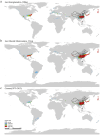Genomics reveal population structure, genetic diversity and evolutionary history of Phyllostachys edulis (moso bamboo) in global natural distribution
- PMID: 40443442
- PMCID: PMC12119579
- DOI: 10.3389/fpls.2025.1532058
Genomics reveal population structure, genetic diversity and evolutionary history of Phyllostachys edulis (moso bamboo) in global natural distribution
Abstract
Introduction: Moso bamboo (Phyllostachys edulis) is widespread in natural forests over large areas in China.
Methods: Here we collected 193 individuals of moso bamboo from 37 natural populations in China's distribution area. Genotyping by sequencing (GBS) was employed to elucidate the genetic diversity, genetic structure, selection pressure, history and adaptive distribution prediction of moso bamboo.
Results: The results revealed that the moso bamboo in China can be divided into central α, eastern β and southern γ subpopulations, with the α-subpopulation presumed to be the origin center. Notably, the genetic diversity of moso bamboo populations were relatively low, and the heterozygotes were excess. At the subpopulation level, the genetic diversity of α-subpopulation was the highest and that of β-subpopulation was the lowest. Analysis of population selection pressure during the transmission of moso bamboo indicated significant genetic differences among subpopulations. Furthermore, 3681 genes related to adaptability, stress resistance, photosynthesis, and hormone were identified from the selected regions. Four SNP markers developed and validated. Based on the population dynamics history and distribution simulation, we found that the distribution of moso bamboo has been influenced by the climate change in geological history.
Discussion: These findings hold significant implications for enhancing our genetic comprehension of bamboo populations and exploring germplasm resources.
Keywords: GBS; Phyllostachys edulis; genetic variation; germplasm resources; population structure.
Copyright © 2025 Li, Fang, Zhou, Hu, Cao and Guo.
Conflict of interest statement
The authors declare that the research was conducted in the absence of any commercial or financial relationships that could be construed as a potential conflict of interest.
Figures









References
-
- Ahuja M., Jain S. (2016). Genetic diversity and erosion in plants: Case Histories. (Springer; ) 8, 357–407. doi: 10.1007/978-3-319-25954-3 - DOI
-
- Araújo B., Luoto M. (2007). The importance of biotic interactions for modelling species distributions under climate change. Global Ecol. Biogeogr. 16, 743–753. doi: 10.1111/j.1466-8238.2007.00359.x - DOI
-
- Cai M., Wen Y., Uchiyama K., Onuma Y., Tsumura Y. (2020). Population genetic diversity and structure of ancient tree populations of cryptomeria japonica var. sinensis based on RAD-seq data. Forests 11, 1192. doi: 10.3390/f11111192 - DOI
LinkOut - more resources
Full Text Sources

